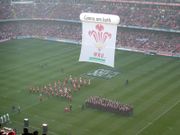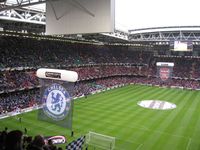Millennium Stadium
| Millennium Stadium Stadiwm y Mileniwm |
|
|---|---|
 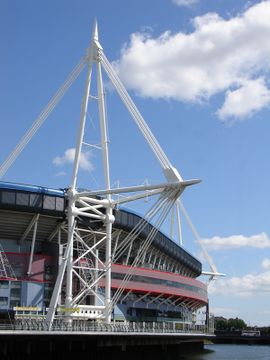 The West Stand of the Millennium Stadium |
|
| Location | Cardiff, Wales |
| Coordinates | |
| Broke ground | 1997 |
| Opened | 26 June 1999[1] |
| Owner | Welsh Rugby Union |
| Operator | Welsh Rugby Union |
| Surface | Grass |
| Construction cost | £121 million[2] |
| Architect | Populous WS Atkins[3] |
| Capacity | 74,500[4] |
| Field dimensions | 120 × 79 m (390 × 259 ft)[4] |
| Tenants | |
| Welsh Rugby Union (National team) Football Association of Wales (National team) |
|
The Millennium Stadium (Welsh: Stadiwm y Mileniwm) is the national stadium of Wales, located in the capital, Cardiff. It is the home of the Wales national rugby union team and the Wales national football team but is also host to many other large scale events, such as the Super Special Stage of Wales Rally Great Britain, Speedway Grand Prix of Great Britain, boxing and many music concerts, including Tina Turner, Madonna, The Rolling Stones, U2, Stereophonics and the Tsunami Relief concert. It was built ready for Cardiff to host the 1999 Rugby World Cup.
The Millennium Stadium is owned by Millennium Stadium plc which is a subsidiary company of the Welsh Rugby Union (WRU).[5] The stadium was designed by a team led by architects Lobb Sport Architecture, who merged to become HOK Sport Venue Event, they are now known as Populous. WS Atkins were the structural engineers and the building contractor was Laing. The total construction cost of the stadium was £121 million,[2] of which the Millennium Commission funded £46 million.[6]
The stadium opened in June 1999,[1] and the first major event to be held was an international rugby union match on 26 June 1999, when Wales beat South Africa in a friendly by 29-19, before a test crowd of 29,000.[7] It is the second largest stadium in the world with a fully retractable roof and was only the second stadium in Europe to have this facility.[8][9] It is the third largest stadium in the Six Nations Championship behind Twickenham and the Stade de France which is the largest.
Contents |
History
Background
Until 1969, Cardiff RFC and Wales both played their home matches on the same pitch at Cardiff Arms Park, but all this would change in the 1969-70 season.[10] As a result of an agreement between Cardiff Athletic Club and the WRU, the National Stadium project had established that a new stadium for international matches and events was required, with Cardiff RFC moving to a new purpose built stadium on the original cricket ground at the site of the former Cardiff Arms Park stadium.[10] By 7 April 1984 the National Stadium was officially opened. However in 1994, a redevelopment committee was set up to consider redeveloping the National Stadium, and by 1995 the WRU had been chosen to host the 1999 Rugby World Cup.[11]
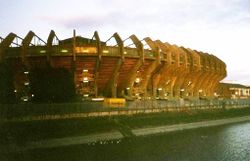
In 1995, the National Stadium, which was designed in 1962,[10] only had a capacity of 53,000; other nations' stadia, such as Twickenham (England) with a capacity of 82,000, and Murrayfield Stadium (Scotland) with a capacity of 67,000, had overtaken it. France was also about to build the Stade de France, which would have a capacity of over 80,000 for the 1998 FIFA World Cup.[11] The original capacity of the National Stadium was 65,000, but this had been reduced to 53,000, due to the Taylor Report. 11,000 of 53,000 capacity was on the East Terrace and the conversion to an all-seater stadium would have reduced the stadium capacity still further to just 47,500.[11]
In addition to the problems of capacity, the National Stadium was also very well hidden by the neighbouring buildings to the south in Park Street, Wood Street and to the east in Westgate Street, and also by Cardiff Rugby Ground in the north. It was only fully visible from across the River Taff in the west. Access to the ground was also very restricted with the main entrance being a narrow opening in Westgate Street to the east which was shared by both vehicles and spectators alike.[11]
The options for the new stadium included adding a third tier to the existing National Stadium, or moving to a new site. This last option was discounted because it would have required a vast car parking facility, and that would have put severe short-term pressures on the local transport infrastructure, creating traffic jams and pollution.[11] The committee eventually chose a new stadium on the same site but with considerable increase in its capacity. It would also involve moving the alignment of the stadium from west-east to north-south. This was the option supported by the Millennium Commission. It would become the fourth redevelopment of the Cardiff Arms Park site.[9] It was also decided that the new stadium should have a sliding roof to accommodate a multi-use venue, with a grass pitch for rugby and football (soccer).[11] The only other sliding roofs in Europe at the time were at two Dutch stadia—the Amsterdam Arena, completed in 1996 with a capacity of 50,000;[9] and Gelredome in Arnhem, a 30,000-capacity ground built from 1996 to 1998.[12]
In order to remain on the Arms Park site, additional space had to be found to allow safe access and to provide room for the increased capacity and improved facilities. This was achieved by the purchase of adjacent buildings to the south and east and by the construction of a new £6 million River Walk by the River Taff on the western side of the stadium.[2]
By 1999 the Millennium Stadium had replaced the National Stadium, Cardiff Arms Park, as the national stadium of Wales for rugby union and association football international matches. Cardiff RFC continued as before to play at Cardiff Arms Park rugby ground, which had replaced the cricket ground in 1969.[10][13]
Construction
The Millennium Stadium during construction
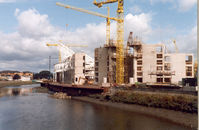
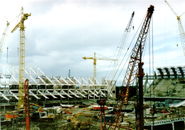
and the North Stand (right)

Construction involved the demolition of a number of buildings, primarily the existing National Stadium (Cardiff Arms Park), Wales Empire Pool (swimming pool) in Wood Street, Cardiff Empire Telephone Exchange building (owned by BT) in Park Street, the newly built Territorial Auxiliary & Volunteer Reserve building in Park Street and the Social Security offices in Westgate Street.[9][14]
The stadium was built by Laing in 1999 on the site of the National Stadium, with the head of construction being Steve Ager.[15] It was built for the 1999 Rugby World Cup, for which Wales was the main host,[9] with seven of the 41 matches, including the final, being played at the stadium.
The total construction cost of the stadium was £121 million,[2] which was funded by private investment and £46 million of public funds from the Millennium Commission,[6] the sale of debentures to supporters (which offered guaranteed tickets in exchange for an interest-free loan), and loans. The development left the WRU heavily in debt.
The Millennium Stadium was first used for a major event on 26 June 1999, when Wales played South Africa in a rugby union friendly match before a test crowd of 29,000. Wales won the match 29-19: the first time they had ever beaten the Springboks.[7]
Features

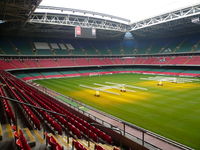
The all-seater stadium has the capacity for 74,500 supporters and features a retractable roof,[4] only the second stadium of its type in Europe, and the largest football stadium in the world with this feature, by capacity.[8] Additional seating is sometimes added for special events such as a rugby Test against the New Zealand All Blacks, or for the FA Cup Final. The current record attendance is 74,576, recorded at Wales' 30–15 victory over Scotland in the 2008 Six Nations Championship on 9 February 2008.[16]
The natural grass turf is a made up of a modular system installed by GreenTech ITM.[17] It features built in irrigation and drainage. The pitch itself is laid on top of some 7,412 pallets which can be moved so the stadium can be used for concerts, exhibitions and other events.[4][18]
The four ends of the ground are called the North Stand, the West Stand, the South Stand, and the BT Stand (east).[19] The South Stand was previously known as the Hyder Stand,[20] until Hyder plc was sold. The stadium has 3 tiers of seating with the exception of the North Stand, which has 2 tiers. The lower tier holds approximately 23,500 spectators, the middle tier holding 18,000 and the upper tier holding 33,000 spectators.[4]
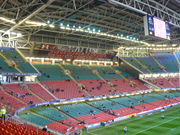
The stadium was slightly restricted in size due to its proximity to Cardiff Rugby Club's home in the adjacent smaller stadium within Cardiff Arms Park. The WRU were unable to secure enough funding to include the North Stand in the new stadium, and the Millennium Commission would not allow any of its funds to be used in any way for the construction of a new stadium for Cardiff RFC.[21] The WRU held talks with CRFC Ltd to see if it would be possible for the club to either move or secure funding for the Cardiff Arms Park to be re-developed, but these were unsuccessful. The stadium thus had to be completed with a break in its bowl structure in the North Stand, known colloquially as Glanmor's Gap, after Glanmor Griffiths, then chairman of the WRU and now a former president.[22]
The superstructure of the stadium is based around four 90.3-metre (296 ft) masts. The stadium was built from 56,000 tonnes of concrete and steel, and has 124 hospitality suites and 7 hospitality lounges,[4] 22 bars, 7 restaurants, 17 first aid points, 12 escalators and 7 lifts.[23] The stadium has 7 gates for access to the site; Gate 1 is from the River Walk via Castle Street (to the north), Gates 2 and 3 are via Westgate Street (to the east), Gate 4 is for Security only also via Westgate Street, Gate 5 is via Park Street (to the south) and Gates 6 and 7 are via the Millennium Plaza (also to the south).[24]
Further stadium development is expected to commence before at least 2020. Any renovation will involve replacing the old North Stand of the former National Stadium with a new stand similar to the three existing stands of the new Millennium Stadium. This will make the stadium bowl shaped and will increase capacity to over 80,000. It will resolve the existing problems of deteriorating concrete quality on the old structure in the north stand.[25]
In each of the stadium's bars, so-called "joy machines" can pour 12 pints in less than 20 seconds. During a Wales Vs France match, 63,000 fans drank 77,184 pints of beer, almost double the 44,000 pints drunk by a similar number of fans at a game at Twickenham.[26] The stadium has a resident hawk named "Dad", who is employed to drive seagulls and pigeons out of the stadium.[27]
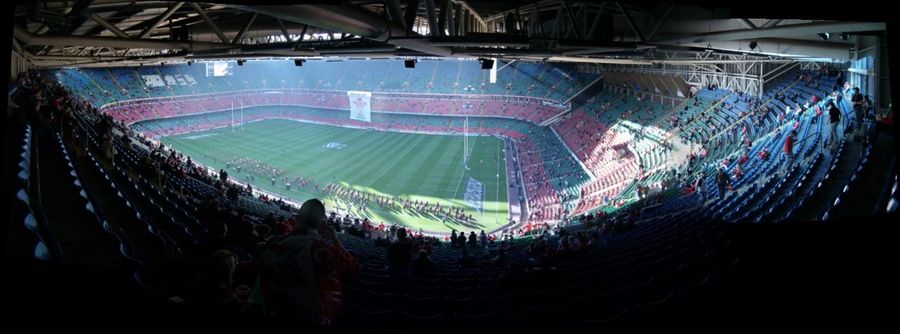
Usage
As well as international rugby union and association football, the Millennium Stadium has hosted a variety of sports, including, rugby league (including the Challenge Cup final on 3 occasions between 2003 and 2005, and Welsh Rugby League internationals), speedway, boxing, the Wales Rally Great Britain stage of the World Rally Championship, Monster Jam and indoor cricket. The indoor cricket match between The Brits and a Rest of the World team for the Pertemps Power Cricket Cup, which took place on 4 and 5 October 2002.[28][29][30]
Rugby union
The stadium is the home of the Welsh rugby union team, who play all of their home fixtures at the venue. These games include those during the Six Nations, as well as the November Tests against nations from the Southern Hemisphere. Apart from the national team the stadium has been used for Celtic League games, as well as Heineken Cup matches.
The stadium has also hosted 3 pool matches and 1 quarter-final match (New Zealand 18-20 France) of the 2007 Rugby World Cup.[31][32][33][34]
The stadium has hosted the semi-finals of the Anglo-Welsh Cup in 2006 and 2007, as well as Heineken Cup finals in:
2001-02 Leicester Tigers 15 - 9 Munster[35]
2005-06 Munster 23 - 19 Biarritz [36]
2007-08 Toulouse 13 - 16 Munster[37]
The stadium will also host the final of the 2010–11 Heineken Cup.
Rugby league
The Millennium Stadium has hosted three of rugby league's Challenge Cup Finals, one of the biggest annual showpiece events the UK's sporting calendar.
Also, in 2007 the stadium hosted the inaugural Millennium Magic weekend. This was a 2-day event in May when an entire round of Super League matches were played, three games on the Saturday and three games on the Sunday. The event was deemed a success by the sport's governing body, the RFL, and second Millennium Magic event took place in May 2008, although the 2009 and 2010 events were held at Murrayfield Stadium and were renamed Magic Weekend. In 2011, Magic Weekend will move back to Cardiff and will be played during the opening round of Super League.[38]
Three rugby league internationals have also been held there. Two were on 5 November 2000 in the 2000 Rugby League World Cup when Lebanon and Cook Islands drew 22–22 and Wales lost to New Zealand 58–18. Wales also lost to New Zealand at the Millennium Stadium in 2002.
Association football
Since 2000, the stadium has also been the almost-permanent home of Welsh football. The national team play the vast majority of home matches at the Millennium Stadium, with a handful of friendly matches once or twice a year at the Racecourse Ground, Wrexham or Liberty Stadium, Swansea.[39][40][41] The first Welsh football game at the stadium was held in 2000 was against Finland,[42] and drew a then-record home crowd for Welsh football of over 66,000.[43] This has since been beaten on several occasions.
In 2001, the Football Association of Wales (FAW) confirmed that they had bid to host the 2003 UEFA Champions League Final. The stadium had recently been rated as a five-star stadium by UEFA, making it one of the favourites to host the match,[44] but the final was eventually awarded to Old Trafford, the home of Manchester United.[45]
It was likely that the stadium would have been one of the venues of a proposed UEFA Euro 2016 championship hosted jointly by Wales and Scotland.[46]. However the bid did not reach the formal UEFA selection stage having been abandoned by the Welsh and Scottish FA's for financial reasons.
Recently, due to a dip in form of the national team subsequently causing a decrease in attendances, the FAW have been considering holding the matches at other venues such as the Liberty Stadium and the newly constructed Cardiff City Stadium.[47]
Whilst the Millennium Stadium was under construction, the original 1923 Wembley Stadium had hosted the Welsh rugby team during the building of the new ground. The favour was returned from 2001 whilst England's national stadium, Wembley Stadium was undergoing rebuilding, with the Millennium hosting:
- FA Cup Final
- League Cup Final
- Football League Trophy Final
- Football League play-off Finals
- FA Community Shield
- Challenge Cup
The stadium became notorious for an apparent "away team hoodoo".[48] The first twelve major cup finals were all won by the teams occupying the home dressing room with their fans in the North Stand. Stoke City beat Brentford 2-0 in 2002 to end the "hoodoo", after Paul Darby carried out a feng shui blessing. This may have been little more than a publicity stunt.[48][49]
Liverpool were the first team to win the FA Cup at the Millennium Stadium in 2001 after beating Arsenal 2-1.[50] Fittingly they also won the last FA Cup to be held at the Millennium Stadium in 2006, after beating West Ham United 3-1 in a penalty shootout that followed a 3-3 draw after extra time in a final that was billed as 'the best cup final of the modern era'.[51]
The Football League Third Division play-offs in 2003 saw A.F.C. Bournemouth beat Lincoln City 5–2. In this game, Bournemouth set a new record for the most goals scored by one team in a single match at the stadium. This record has been matched but not beaten since.[52]
The last domestic cup match played was when Doncaster Rovers beat Bristol Rovers 3-2 after extra time in the Football League Trophy Final on 1 April 2007.[53]
Boxing
There have been 3 nights of boxing at the stadium.[54] On 8 July 2006 when Matt Skelton beat Danny Williams for the Commonwealth heavyweight title.[55] On 7 April 2007 Joe Calzaghe beat Peter Manfredo to retain his WBO super middleweight belt.[56] On 3 November 2007 Calzaghe beat Mikkel Kessler to retain his WBO super middleweight belt and win the WBA and WBC super middleweight titles.[56]
Motorsports
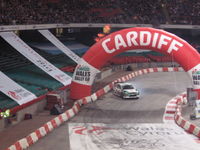
In 2001 it staged its first ever motorsport event, hosting the Speedway Grand Prix of Great Britain, and has done every year since, in 2007 attracting a record crowd of 41,247, a record for British Speedway.[57]
In September 2005 the stadium was host to the first ever indoor stage of the World Rally Championship during the Wales Rally Great Britain. The lower tier of the stadium was removed to create a figure-of-eight course.[58] In addition to this, the stadium has also hosted Supercross events.[59] In October 2007, the stadium first hosted the UK leg of the Monster Jam trucks Europe tour, and returned again in June 2008[60]
Film
The stadium has also on occasion been used as a venue for shooting film and television productions. "Dalek",[61] an episode of the 2005 season of the BBC science fiction television series Doctor Who, was shot primarily on location at the stadium, using its underground areas to stand in for an underground base in Utah, United States in the year 2012. The location shooting for the episode took place during October and November 2004. The underground areas of the stadium were used again in Doctor Who for the 2005 Christmas special, "The Christmas Invasion".[62] The area was used as the headquarters for UNIT,[62] based under the Tower of London. The episode was broadcast on Christmas Day 2005. The Hindi film Kabhi Khushi Kabhi Gham was also filmed there.[63]
The Wembley Stadium scene in the film 28 Weeks Later was actually filmed at the Millennium Stadium. Although the outside is footage of Wembley, the inside is all filmed in Cardiff. The effects team on the film edited the footage to make it look more like Wembley.[64]
Sébastien Foucan jumped over the gap of the opening of the stadium roof in the parkour documentary "Jump Britain".
London 2012 Olympics
For the 2012 Summer Olympics, the stadium will also be one of the hosts for the football events hosting at least eight football matches.[65]
Eventing
The inaugural Express Eventing International Cup took place at the stadium on 30 Nov 2008. The three-event competition made up of dressage, cross-country and show jumping all took place over the one day. The event was won by Oliver Townend.[66]
Music concerts
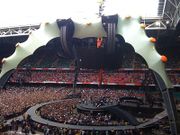
The stadium has also been used for a variety of musical events, including the Manic Street Preachers concert held on Millennium Eve,[67] and, on the following day, a recording of the BBC's Songs of Praise, which attracted an attendance of 60,000. [68] Tina Turner performed a sold-out concert at the stadium during her highly successful Twenty Four Seven Tour in 2000.[69] Welsh rockers Stereophonics have played two sold out shows at the stadium: In July 2001 as part of their two day "A Day at the Races" festival which would later be released to DVD and in 2003, shortly after the departure of the late Stuart Cable. At the end of January 2005, the stadium hosted a tsunami relief concert in aid of the victims of the 2004 Indian Ocean earthquake and tsunami, with Eric Clapton headlining the event.[70] The stadium has also been host to Madonna on two occasions, the first in July 2006 when she opened the UK leg of her Confessions Tour,[71] and most recently in August 2008 when she kicked off her Sticky & Sweet Tour at the stadium.[72] Other performers who have played at the stadium include Robbie Williams as part of his Weddings, Barmitzvahs & Stadiums Tour,[73] U2 as part of their Vertigo Tour ,[74] Red Hot Chili Peppers as part of their By the Way tour,[75] The Rolling Stones as part of their A Bigger Bang Tour,[76] Bon Jovi as part of their One Wild Night Tour,[77] R.E.M.,[74] Paul McCartney as part of his Up and Coming Tour,[78] and The Police as part of their Reunion Tour.[79] In late 2005, Oasis played at the stadium during their Don't Believe the Truth Tour and again on their Dig Out Your Soul Tour in 2009.[80] In 2008, the stadium hosted Neil Diamond and Bruce Springsteen with the E Street Band as part of their Magic Tour,[81] On 22 August 2009, U2 again played at the stadium, as part of their European leg of their U2 360° Tour,[82] playing to a record-breaking concert attendance of 73,354.[83]
See also
- Sport in Cardiff
- List of football clubs' appearances at the Millennium Stadium
- Millennium Stadium Charitable Trust
- List of stadiums by capacity
- List of covered stadiums by capacity
- List of stadia in Wales by capacity
- List of European stadia by capacity
- List of association football stadiums by capacity
References
- ↑ 1.0 1.1 "Millennium Stadium Information". Millennium Stadium. http://www.millenniumstadium.com/3473_3515.php. Retrieved 2008-08-28.
- ↑ 2.0 2.1 2.2 2.3 "The Economic Impact of the Millennium Stadium". Cardiff Council. http://www.cardiff.gov.uk/ObjView.asp?Object_ID=3880. Retrieved 2008-09-07.
- ↑ "Pulling off the wow factor". Federation of Master Builders. http://www.fmb.org.uk/publications/masterbuilder/june00/19.asp. Retrieved 2008-08-28.
- ↑ 4.0 4.1 4.2 4.3 4.4 4.5 "Facts & Figures". Millennium Stadium. http://www.millenniumstadium.com/information/facts_and_figures.php. Retrieved 19 July 2010.
- ↑ "About Millennium Stadium plc". Welsh Rugby Union Limited. http://www.wru.co.uk/809_14196.php. Retrieved 2008-08-24.
- ↑ 6.0 6.1 "Millennium projects open in Wales and Northern Ireland". Millennium Commission. http://www.millennium.gov.uk/cgi-bin/item.cgi?id=1517. Retrieved 2008-08-24.
- ↑ 7.0 7.1 "Millennium Stadium celebrates fifth anniversary". NewsWales. 2004-06-25. http://www.newswales.co.uk/?section=Sport&F=1&id=7122.
- ↑ 8.0 8.1 "Fact About Wales and the Welsh (40. Cardiff has the world's largest retractable-roof arena)". Britannia.com, LLC. http://www.britannia.com/celtic/wales/facts/facts7.html. Retrieved 2008-09-07.
- ↑ 9.0 9.1 9.2 9.3 9.4 "About Millennium Stadium". Millennium Stadium plc. http://www.millenniumstadium.com/3473_3557.php. Retrieved 2008-08-24.
- ↑ 10.0 10.1 10.2 10.3 Harris CBE LLD (Hons), Kenneth M (1984). The Story of the Development of the National Rugby Ground 7 April 1984. Welsh Rugby Union.
- ↑ 11.0 11.1 11.2 11.3 11.4 11.5 "In the heart of the city". PanStadia International. http://www.panstadia.com/vol3/33-022.htm. Retrieved 2008-08-24.
- ↑ "Projecten: Gelredome, Arnhem" (in Dutch). Alynia Architecten. http://www.alynia-architecten.nl/projecten/sport02.htm. Retrieved 2009-02-15.
- ↑ "CRFC History". www.Cardiff RFC. http://site.cardiff-rfc.co.uk/index.php?option=com_content&task=view&id=31&Itemid=68. Retrieved 2008-08-27.
- ↑ "Two years - and one awesome stadium". BBC. 1999-09-02. http://news.bbc.co.uk/2/hi/uk_news/wales/436549.stm. Retrieved 2008-08-24.
- ↑ "Cardiff stadium 'financial disaster'". BBC. 1999-09-09. http://news.bbc.co.uk/1/hi/wales/442978.stm. Retrieved 2008-08-28.
- ↑ "Wales 30 Scotland 15". wru.co.uk. 2008-02-09. http://www.wru.co.uk/63_16846.php. Retrieved 2008-03-20.
- ↑ "Millennium Stadium, Cardiff, Wales". GreenTech, Inc.. http://www.greentechitm.com/project/default.asp?fpID=4A89B3AD-54F5-472C-BC95-D96C9DE3CAA5. Retrieved 2008-08-24.
- ↑ "Cardiff pioneers new turf". Fat Pig Productions CC. http://www.sarugby.com/news/News/article/sid=8302.html. Retrieved 2008-08-24.
- ↑ "Millennium Stadium Information (Millennium Stadium Seating Plan)". Millennium Stadium plc. http://www.millenniumstadium.com/3473_3564.php. Retrieved 2008-09-07.
- ↑ "Hyder Stand South". Liverpoolfc.tv Ltd. http://www.liverpoolfc.tv/cardiff2.htm. Retrieved 2008-09-07.
- ↑ "Stadia, Arenas and Grandstands By P. Thompson, J. J. A. Tolloczko, Jean Benedetti, J. N. Clarke, Concrete Society". Taylor & Francis, 1998 & Google Books. http://books.google.com/books?id=o0BsU6JbpYAC&pg=PR9&dq=national+lottery+commission+Millennium+stadium+for+the+construction+of+the+club+ground.&source=gbs_selected_pages&cad=0_1&sig=ACfU3U2vgwZWq84tb9X_fC20S3dwm5W2KA#PPA224,M1. Retrieved 2008-09-04.
- ↑ "Presidents of the WRU". Welsh Rugby Union Ltd. http://www.wru.co.uk/809_14159.php. Retrieved 2008-08-24.
- ↑ "BBC Sport Online's Mark Barden looks at Cardiff's Millennium Stadium". BBC. 2001-01-04. http://news.bbc.co.uk/sport1/hi/football/1100390.stm. Retrieved 2008-08-24.
- ↑ "Stadium Location Content". Millennium Stadium plc. http://www.millenniumstadium.com/3473_3564.php. Retrieved 2008-08-27.
- ↑ Bevan, Nathan (2007-07-08). "Concrete cancer strikes stadium". Wales on Sunday. http://icwales.icnetwork.co.uk/0100news/0200wales/tm_headline=millennium-stadium-has-concrete-cancer%26method=full%26objectid=19422108%26siteid=50082-name_page.html. Retrieved 2007-08-24.
- ↑ "48 hours in Cardiff" (PDF). The Visitwales Centre. http://www.visitwales.ie/upload/pdf/48hours.pdf. Retrieved 2008-08-24.
- ↑ "Millennium Stadium Hawk Takes A Break". Millennium Stadium. 2007-03-22. http://www.millenniumstadium.com/197_9910.php.
- ↑ "History of the Millennium Stadium". Millennium Stadium. http://www.millenniumstadium.com/history/index.php. Retrieved 2009-11-27.
- ↑ "Power Cricket To Return To Millennium Stadium In 2003". Chipping Sodbury Cricket Club. http://www.chippingsodburycc.co.uk/cricket-news/power-cricket-to-return,111.htm. Retrieved 2009-11-27.
- ↑ "Pertemps sponsors international cricket". Pertemps Ltd. http://www.pertemps.co.uk/content/news0209. Retrieved 2009-11-27.
- ↑ "Wales 20-32 Australia". BBC. 2007-09-15. http://news.bbc.co.uk/sport1/hi/rugby_union/welsh/6995680.stm. Retrieved 2008-08-29.
- ↑ Malin, Ian (2007-09-17). "Fiji send Wales a mixed message". London: Guardian News and Media Limited. http://www.guardian.co.uk/sport/2007/sep/17/rugbyunion.rugbyworldcup200713. Retrieved 2008-08-29.
- ↑ "Wales 72-18 Japan". BBC. 2007-09-20. http://news.bbc.co.uk/sport1/hi/rugby_union/7004082.stm. Retrieved 2008-08-29.
- ↑ Fotheringham, William (2007-10-08). "France postpone party to avoid another hangover". London: Guardian News and Media Limited. http://www.guardian.co.uk/sport/2007/oct/08/rugbyunion.rugbyworldcup200714. Retrieved 2008-08-29.
- ↑ "The Seventh Heineken Cup Final". ERC and Westgate. http://www.ercrugby.com/eng/85_866.php. Retrieved 2008-08-29.
- ↑ "Munster fulfil their destiny". ERC and Westgate. http://www.ercrugby.com/eng/5479_5287.php. Retrieved 2008-08-29.
- ↑ "Munster claim second Heineken Cup". ERC and Westgate. http://www.ercrugby.com/eng/12_10240.php. Retrieved 2008-08-29.
- ↑ "Millennium Magic to start 2011 Super League season". BBC. http://news.bbc.co.uk/sport2/hi/rugby_league/8912387.stm. Retrieved 2010-08-14.
- ↑ "'Old' stadium claims world record". BBC. 2008-08-20. http://news.bbc.co.uk/1/hi/wales/north_east/7571023.stm. Retrieved 2008-09-07.
- ↑ "Wales v Bulgaria - Friendly. - Liberty Stadium Swansea. Tuesday 15th August 2006.". www.dragonsoccer.co.uk. http://www.dragonsoccer.co.uk/matches/fr_00022.htm. Retrieved 2008-09-07.
- ↑ "Wales 1-2 Georgia". BBC. 2008-08-20. http://news.bbc.co.uk/sport1/hi/football/internationals/7556448.stm. Retrieved 2008-09-07.
- ↑ "FA Cup bid for Wales". BBC. 2000-05-30. http://news.bbc.co.uk/1/hi/wales/769672.stm. Retrieved 2008-09-03.
- ↑ "Football: Hughes and Wales hope Finland feel the force of Giggs". The Independent, London also CNET Networks, Inc., a CBS Company.. http://findarticles.com/p/articles/mi_qn4158/is_20000329/ai_n14285673. Retrieved 2008-09-03.
- ↑ Ley, John (10 January 2001). "Welsh eye European final". Telegraph.co.uk (London: Telegraph Media Group). http://www.telegraph.co.uk/sport/2996221/Welsh-eye-European-final.html. Retrieved 18 April 2009.
- ↑ Ziegler, Martyn (14 December 2001). "Old Trafford lands 2003 final". independent.co.uk (London: Independent News and Media). http://www.independent.co.uk/sport/football/news-and-comment/old-trafford-lands-2003-final-620162.html. Retrieved 18 April 2009.
- ↑ "Wales eye joint Scotland Euro bid". BBC. 2007-04-19. http://news.bbc.co.uk/sport1/hi/football/league_of_wales/6175393.stm. Retrieved 2008-09-03.
- ↑ "Wales to play Scotland at Cardiff City Stadium". Media Wales Ltd. http://www.walesonline.co.uk/footballnation/football-news/2009/10/03/wales-to-play-scotland-at-cardiff-city-stadium-91466-24840518/. Retrieved 2009-11-20.
- ↑ 48.0 48.1 "Wales Sense Room For Improvement". Yahoo! and Eurosport. http://uk.eurosport.yahoo.com/09022008/4/wales-sense-room-improvement.html. Retrieved 2008-08-27.
- ↑ "McFengshui Mojo Missing at Millennium Stadium". Feng Shui Ultimate Resource. http://www.qi-whiz.com/node/1035. Retrieved 2008-08-27.
- ↑ "Arsenal Undone as Owen's Late Double Gives Liverpool Cup". International Herald Tribune. http://www.iht.com/articles/2001/05/14/cup_ed3__3.php. Retrieved 2008-09-04.
- ↑ "Millennium Stadium memories". BBC. 2007-04-02. http://news.bbc.co.uk/sport1/hi/football/6514009.stm. Retrieved 2008-09-04.
- ↑ "Leeds United Versus Bournemouth". Vital Network Ltd. http://www.leeds.vitalfootball.co.uk/sitepage.asp?a=73362. Retrieved 2008-09-04.
- ↑ "Rovers match marks city final end". BBC. 2007-04-01. http://news.bbc.co.uk/1/hi/wales/south_east/6515373.stm. Retrieved 2008-09-03.
- ↑ "Millennium Stadium, Cardiff, Wales, United Kingdom". BoxRec. http://boxrec.com/location.php?country_code=UK®ion_name=null&towncity_name=&towncity_id=22698&venue_name=&venue_id=25665&yyyy=&submit=Go. Retrieved 2010-01-03.
- ↑ "boxer: Matt Skelton". BoxRec. http://boxrec.com/list_bouts.php?human_id=141021&cat=boxer. Retrieved 2010-01-03.
- ↑ 56.0 56.1 "boxer: Joe Calzaghe". BoxRec. http://boxrec.com/list_bouts.php?human_id=5364&cat=boxer. Retrieved 2010-01-03.
- ↑ "Bomber wins in Cardiff". BBC. http://www.bbc.co.uk/oxford/content/articles/2007/07/02/bomber.shtml. Retrieved 2008-09-03.
- ↑ "Stadium first for world rally". BBC. 2005-09-17. http://news.bbc.co.uk/1/hi/wales/4255386.stm. Retrieved 2008-09-03.
- ↑ "Crockard second in Wales". BBC. 2004-12-06. http://news.bbc.co.uk/sport1/hi/motorsport/motorbikes/4071727.stm. Retrieved 2008-09-03.
- ↑ "Monster Jam". Millennium Stadium plc. http://www.millenniumstadium.com/301_416.php. Retrieved 2008-09-03.
- ↑ "Doctor Who Locations - Millennium Stadium". Christian Graham. http://www.doctorwholocations.org.uk/mapper/show/60.html. Retrieved 2008-09-04.
- ↑ 62.0 62.1 "New Series Episode 15:The Christmas Invasion". Shannon Patrick Sullivan. http://www.shannonsullivan.com/drwho/serials/2005o.html. Retrieved 2008-09-04.
- ↑ "Live - Carling Cup final". BBC. 2007-02-25. http://news.bbc.co.uk/sport1/hi/football/league_cup/6392761.stm. Retrieved 2008-09-05.
- ↑ "Titles with locations including Millennium Stadium, Cardiff". Internet Movie Database. http://www.imdb.com/List?endings=on&&locations=Millennium%20Stadium,%20Cardiff,%20South%20Glamorgan,%20Wales,%20UK&&heading=18;with+locations+including;Millennium%20Stadium,%20Cardiff,%20South%20Glamorgan,%20Wales,%20UK. Retrieved 2008-08-27.
- ↑ "2012 Olympics roadshow rolls in". BBC. 2006-07-17. http://news.bbc.co.uk/1/hi/wales/5189154.stm. Retrieved 2008-09-03.
- ↑ "Brits make a clean sweep of Express Eventing". Tricorn Events Limited. http://www.eeicup.com/pressreleases.asp. Retrieved 2009-02-21.
- ↑ "Manic Street Preachers biography". BBC. http://www.bbc.co.uk/wales/music/sites/manicstreetpreachers/pages/manics_biography.shtml. Retrieved 2008-09-04.
- ↑ "Fascinating facts about Songs of Praise...". BBC. http://www.bbc.co.uk/religion/programmes/songsofpraise/features/did_you_know/. Retrieved 2008-09-04.
- ↑ "Twenty Four Seven Tour 2000". Official Tina Turner Fan Club. http://www.tinaturnerfanclub.eu/tours/twenty_four_seven_tour.html. Retrieved 2008-09-04.
- ↑ "Stadium tsunami gig raises £1.25m". BBC. 2005-01-23. http://news.bbc.co.uk/1/hi/wales/4195985.stm. Retrieved 2008-09-04.
- ↑ "Confessions from a Madonna show". BBC. 2006-07-31. http://news.bbc.co.uk/1/hi/wales/5224584.stm. Retrieved 2008-09-04.
- ↑ "Madonna kicks off huge world tour". BBC. 2008-08-23. http://news.bbc.co.uk/1/hi/entertainment/7579275.stm. Retrieved 2008-09-04.
- ↑ "'Robbie Weekend' draws 120,000 fans". BBC. 2001-07-16. http://news.bbc.co.uk/1/hi/wales/1438599.stm. Retrieved 2008-09-04.
- ↑ 74.0 74.1 "Stadium hopes for big star names". BBC. 2005-06-01. http://news.bbc.co.uk/1/hi/wales/4599957.stm. Retrieved 2008-09-04.
- ↑ "Windsurfing in stadium profit plan". BBC. 2004-06-23. http://news.bbc.co.uk/1/hi/wales/3829409.stm. Retrieved 2008-09-04.
- ↑ "Madonna to open tour in Cardiff". BBC. 2006-04-04. http://news.bbc.co.uk/1/hi/wales/south_east/4873036.stm. Retrieved 2008-09-04.
- ↑ "Cardiff set to be recreation capital". BBC. 2001-06-27. http://news.bbc.co.uk/1/low/wales/1410180.stm. Retrieved 2008-09-04.
- ↑ http://www.macca-central.com/macca-concerts/concert_popup.php?ID=589&ID1=581&BM=YES&SL=NO&ML=NO
- ↑ "Police gig for Millennium Stadium". BBC. 2007-03-05. http://news.bbc.co.uk/1/hi/wales/6418637.stm. Retrieved 2008-09-04.
- ↑ "Oasis headline stadium rock gig". BBC. 2005-07-25. http://news.bbc.co.uk/1/hi/wales/4714401.stm. Retrieved 2008-09-04.
- ↑ "Low sales blamed as REM move show". BBC. 2008-08-08. http://news.bbc.co.uk/1/hi/wales/south_east/7550253.stm. Retrieved 2008-09-04.
- ↑ "U2 360 Tour Presented by BlackBerry, Revolutionary Production Design Revealed". Fox Business Network. http://www.foxbusiness.com/story/markets/industries/finance/u--tour-presented-blackberry-revolutionary-production-design-revealed/. Retrieved 2009-03-14.
- ↑ "U2 Rock to Record-Breaking Crowd at Millennium Stadium". Millennium Stadium. http://www.millenniumstadium.com/news/22051.php. Retrieved 2010-08-26.
External links
- Official website of the Millennium Stadium
- Millennium Stadium on the BBC website
- Millennium Stadium on the Populous website
|
|||||||||||||||||||||||||||||||||||||||||||||||||||||||||||||||||||||||||||||||||||||||||||||||||||||||||||||||||||||
